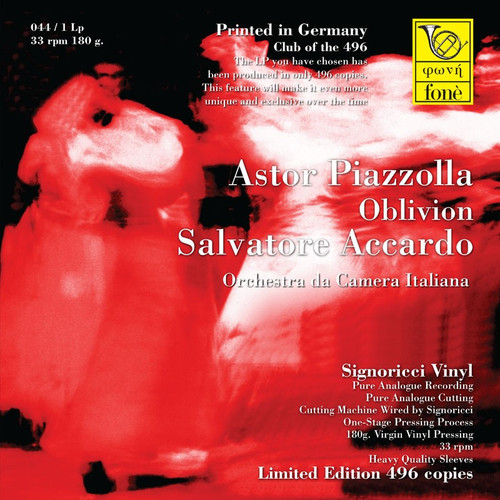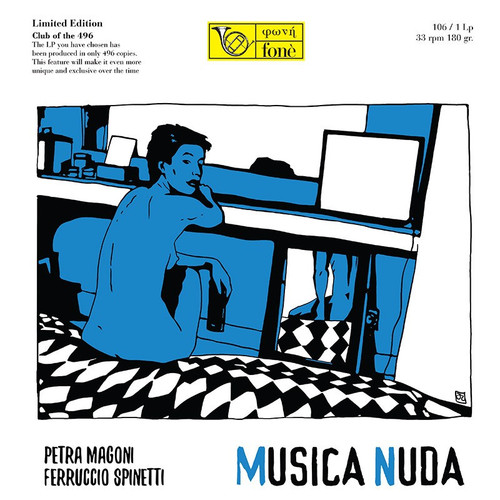Rainer Maillard (Producer of the direct-to-disc recording): »I met the five members of the Bolivar Soloists during a recording session with Rolando Villazon and was immediately thrilled by their passion, joy in music-making, musicality, virtuosity and temperament. Everything just gushed out of them in profusion. I asked them if they would like to make a direct-to-disc recording with me. Well, actually I had to first explain to them what was meant by the term. They had no idea what it was – and how should they? After all, these days all recordings are made using the most advanced technology available. We, on the other hand, would have a completely analogue recording and reproducing chain, but that was not the crucial factor. I explained to them that they would not only have to play a complete work but a whole LP side in a single take, and that not even one note could be corrected later; the recording sessions would be far more intensive, their pulse rate would rocket during the recording, they would have a quite different feeling when listening to the recording on LP rather than CD, and the musicians and recording team would work together very closely. Ultimately, a direct-to-disc recording would definitely sound quite different to a CD production. That was what I told them. The Bolivar Soloists accepted the offer and it was immediately clear to them that for such a unique project they would record works by their revered Astor Piazzolla. Time passed, but at last we arrived at a date for the recording of seven tangos. The whole process of making a direct-to-disc recording is completely different from a usual recording. During our four days together the first day was given over completely to rehearsing, without a single microphone in the recording studio. The reason is simple: the musicians simply cannot depend on the technical refinement and possibilities of modern sound manipulation. No overdubbing or editing is possible. What one played was exactly what would be heard later – nothing more and nothing less. There were no compromises – preparation is everything. On day three we concerned ourselves with the sound check. The positioning of the musicians, the microphones to be used and their positioning, the level ratio, the echoes, everything was checked and re-checked again and again (we used an analogue tape recorder for this) and then optimized, because of course the same thing was applicable to both the recording team and the musicians: once the recording has taken place, nothing can be done to alter the sound. On the evening of the third day we all felt confident enough to be able to make the real recording the next day. And we even ventured to make a further experiment in that we invited friends and colleagues to attend the recording session. On 17 January 2012 our direct-to-disc recording finally took place. The musicians stood in a circle, surrounded by a small audience. The timing of the beginning of the actual recording had to be discussed briefly because the musicians can only begin with the recording when the lead-in groove of the lacquer disc has been cut. And then we were off; there was no second chance. The Bolivar Soloists played like the devil (or like angels, depending on how you look at it). We cut five lacquers in all, three times the A side, and twice the B side. In between the recordings we took a short break during which intensive discussions took place. After the last take (in this case this was equivalent to the cutting of an LP side) the tension subsided, and we all hugged one another. Juan Manuel, the violinist, even asserted that he had never played so well in all his life. What a statement! And what better reason could one have for using this particular recording technique. Now all we had to do was write the numbers of the recordings on the lacquer discs and cross our fingers that nothing disastrous would happen to them during transport or at the pressing plant. You see, during the pressing procedure of a direct-to-disc recording the adage still holds good: a re-do or undo is just not on.«
»Die fünf Musiker der Bolivar Soloists traf ich bei einer Aufnahme mit Rolando Villazon und war sofort begeistert: Leidenschaft, Spielfreunde, Musikalität, Virtuosität, Temperament – alles strömte nur so im Überfluss aus ihnen heraus. Ich fragte sie, ob sie nicht eine Direct-to-Disc-Aufnahme mit mir machen wollen. Nun, zuerst musste ich ihnen erklären, was ein Direktschnitt überhaupt ist. Sie hatten keine Vorstellung davon – wie auch, denn heute werden alle Aufnahmen mit modernster Technik produziert. Es wird eine komplett analoge Aufnahme und Wiedergabekette geben, aber das ist nicht der ausschlaggebende Punkt. Ich erklärte ihnen, wie eine typische Direktschnitt-Aufnahme funktioniert: Ein einziger Take für eine ganze LP-Seite, keine Korrekturmöglichkeit hinterher, intensive Aufnahmesessions mit viel höherem Puls. Ich erzählte vom anderen Gefühl, die Aufnahme hinterher auf LP statt auf CD zu hören, und von der viel engeren Zusammenarbeit zwischen Musiker und Aufnahmeteam. Schlussendlich: Eine Direct-to-Disc-Aufnahme würde definitiv anders als eine CD-Produktion klingen. Soweit meine Ansprache. Die Bolivar Soloists sagten zu und ihnen war sofort klar: Wenn schon so ein Projekt, dann auch gleich mit Werken von Astor Piazzolla, ihrem großen Vorbild. Es verging einige Zeit, und dann hatten wir endlich einen Termin für die Aufnahme der sieben Tangos gefunden. Alleine der Ablauf solch einer Aufnahme unterscheidet sich schon komplett von einer gewöhnlichen Aufnahme. Von den vier Tagen wurde an den ersten beiden Tagen nur geprobt, ohne dass überhaupt ein Mikrophon im Aufnahmeraum stand. Der Grund ist einfach: Vorbereitung ist alles. Die Musiker können sich nicht auf die technischen Raffinessen und Möglichkeiten moderner Tonmanipulationen verlassen. Man kann nicht nachträglich schneiden. Sie müssen alles so spielen, wie es später gehört werden soll: eins zu eins. Ohne Kompromisse. Am dritten Tag kümmerten wir uns dann nur um den Soundcheck: Die Aufstellungen der Musiker, die Positionierung der Mikrophone, Pegelverhältnisse, Hallräume, alles wurde immer wieder gecheckt und optimiert (zur Abhörkontrolle benutzten wir ein analoges Tonbandgerät), denn für das Aufnahmeteam gilt dasselbe wie für die Musiker: Nach der Aufnahme kann man am Klang nichts mehr ändern. Am Abend des dritten Tages fühlen wir uns sicher genug und vereinbarten endlich für den vierten Tag die richtige Aufnahme. Diesmal wagten wir ein weiteres Experiment: Freunde und Kollegen wurden spontan zur Aufnahme eingeladen. Und so ging die Direct-to-Disc-Aufnahme am 17. Januar 2012 endlich los. Die Musiker standen im Kreis, umrahmt von einem kleinen Publikum. Der Beginn der eigentlichen Aufnahme musste noch kurz abgesprochen werden – schließlich konnten die Musiker erst mit der Aufnahme starten, wenn die Einlaufrille der Lackfolie fertig geschnitten war. Und dann ging es los, und es gab kein Zurück mehr. Die Bolivar Soloists spielten wie die Teufel (oder wie Engel, je nach Betrachtungsweise). Wir schnitten insgesamt fünf Folien, dreimal die A-Seite, zweimal die B-Seite. Zwischen den Aufnahmen gab es kleine Pausen, in denen intensiv diskutiert wurde. Nach dem letzen Take (hier gleichbedeutend mit Schnitt einer Plattenseite) löste sich die Spannung, wir lagen uns in den Armen. Der Geiger Juan Manuel meinte, er habe in seinem Leben noch nie so gut gespielt wie gerade bei dieser Aufnahme. Was für eine Aussage! Und was für ein Argument für dieses Aufnahmeverfahren. Jetzt galt es nur noch, die Lackfolien mit einer eindeutigen Nummer zu beschriften und die Daumen zu drücken, dass beim Transport und bei der Arbeit im Presswerk nichts schief geht. Denn auch für die Entwicklung einer Direct-to-Disc-Aufnahme gilt: Es gibt kein Redo oder Undo.«










